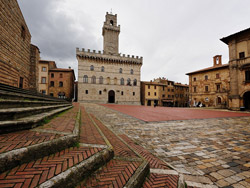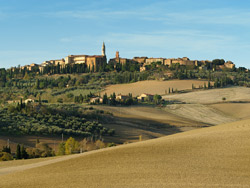








DIDACTIC ACTIVITIES
Didactic, cultural, traditional activities ... related to the rural world
 This is the largest Comune in the Sienese Valdichiana and contains six other villages: Abbadia di Montepulciano, Acquaviva, Gracciano, Montepulciano Stazione, S.Albino and Valiano. The poet Agnolo Ambrogini (known as "il Poliziano" from the Latin "mons Politianus") was born here. The town is said to have been founded by the Etruscan king Porsenna and exhibits impressive architecture, mainly but not only Renaissance.
Michelozzo, Baldassarre Peruzzi and Vignola all worked here, as did Antonio da Sangallo il Vecchio who designed the temple of San Biagio. Apart from the wonders of the historical centre of Montepulciano the tourist would do well to visit the spa centre at S.Albino.
The local economy is based on agriculture and the town is famous for its Vino Nobile. In th summer the town hosts the "Cantiere Internazionale d'arte" and in the mid-Augut holidays the "Bruscello", a traditional show spoken in rhyme, is performed on the Cathedral steps.
On August 29 a wine barrel race, the "Bravžo", is run between the different contrade, or districts, of the town and there is a procession in 13th-century dress.
This is the largest Comune in the Sienese Valdichiana and contains six other villages: Abbadia di Montepulciano, Acquaviva, Gracciano, Montepulciano Stazione, S.Albino and Valiano. The poet Agnolo Ambrogini (known as "il Poliziano" from the Latin "mons Politianus") was born here. The town is said to have been founded by the Etruscan king Porsenna and exhibits impressive architecture, mainly but not only Renaissance.
Michelozzo, Baldassarre Peruzzi and Vignola all worked here, as did Antonio da Sangallo il Vecchio who designed the temple of San Biagio. Apart from the wonders of the historical centre of Montepulciano the tourist would do well to visit the spa centre at S.Albino.
The local economy is based on agriculture and the town is famous for its Vino Nobile. In th summer the town hosts the "Cantiere Internazionale d'arte" and in the mid-Augut holidays the "Bruscello", a traditional show spoken in rhyme, is performed on the Cathedral steps.
On August 29 a wine barrel race, the "Bravžo", is run between the different contrade, or districts, of the town and there is a procession in 13th-century dress.
 The history of Pienza coincides with that of its founder, Enea Silvio Piccolomini, later to become Pope Pio II. When his family, was forced out of Siena, took refuge in Corsignano, in the Val d'Orcia, wehre they owned a house and some land. Enea Silvio was born here in 1450 in a small fortified hamlet built around a Romanesque parish church. Traces have been found that this area was inhabited from the Neolithic to the Bronze age and this hamlet was also known in Roman times. When he became Pope decided to transform his birthplace from a hamlet into a town. He wanted in this place famous architects and artists to create a big plan that was a city, that he renamed Pienza, and at the same time a monument to the Renaissance. He was insipred not so much from religious devotion, but from a dream transform the world through a modern way of thinking which was both tolerant and cosmopolitan. It is difficult to know what Pienza would have become if Pio II had not died suddenly on the eve of his crusade to fight the Muslism on 14th August 1464. However, after his death Pienza remained unchanged, perfectly balanced in its modern geometry. The Piazza Pio II, laid out by Bernardo Rossellino, demonstrates an architectural and philosophical concept that represents the Humanist movement. In the square, the celebrated cathedral "domus vitrea", with a Renassaince facade and a Gothic interior, contains works by some of the finest artists from that period: Giovanni di Paolo, Matteo di Giovanni, il Vecchietta, Sano di Pietro; here you can see fine wooden choir stalls in Gothic style and other sacred works of great value.In the majestic Papal residence Palazzo Piccolomini, there is a museum, in the "sala d'armi" there is a display of arms, you can visit the Pope's Bedroom, the Library and the collection of medals of Pio II and Pio III. The Muse Diocesano (in Palazzo Vescovile) contains beautiful Flemish tapestries from the XV-XVI century and works by Bartolo di Fredi, Vecchietta, Maestro dell'Osservanza, Sano di Pietro and Pellegrino di Marino. In 1996 Pienza was recognised by UNESCO for its cultural value and inscribed on their World Heritage List.
The history of Pienza coincides with that of its founder, Enea Silvio Piccolomini, later to become Pope Pio II. When his family, was forced out of Siena, took refuge in Corsignano, in the Val d'Orcia, wehre they owned a house and some land. Enea Silvio was born here in 1450 in a small fortified hamlet built around a Romanesque parish church. Traces have been found that this area was inhabited from the Neolithic to the Bronze age and this hamlet was also known in Roman times. When he became Pope decided to transform his birthplace from a hamlet into a town. He wanted in this place famous architects and artists to create a big plan that was a city, that he renamed Pienza, and at the same time a monument to the Renaissance. He was insipred not so much from religious devotion, but from a dream transform the world through a modern way of thinking which was both tolerant and cosmopolitan. It is difficult to know what Pienza would have become if Pio II had not died suddenly on the eve of his crusade to fight the Muslism on 14th August 1464. However, after his death Pienza remained unchanged, perfectly balanced in its modern geometry. The Piazza Pio II, laid out by Bernardo Rossellino, demonstrates an architectural and philosophical concept that represents the Humanist movement. In the square, the celebrated cathedral "domus vitrea", with a Renassaince facade and a Gothic interior, contains works by some of the finest artists from that period: Giovanni di Paolo, Matteo di Giovanni, il Vecchietta, Sano di Pietro; here you can see fine wooden choir stalls in Gothic style and other sacred works of great value.In the majestic Papal residence Palazzo Piccolomini, there is a museum, in the "sala d'armi" there is a display of arms, you can visit the Pope's Bedroom, the Library and the collection of medals of Pio II and Pio III. The Muse Diocesano (in Palazzo Vescovile) contains beautiful Flemish tapestries from the XV-XVI century and works by Bartolo di Fredi, Vecchietta, Maestro dell'Osservanza, Sano di Pietro and Pellegrino di Marino. In 1996 Pienza was recognised by UNESCO for its cultural value and inscribed on their World Heritage List.